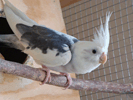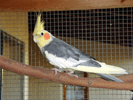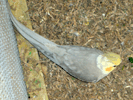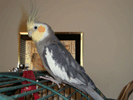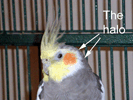Breeding & Genetics
Cockatiel Split Signs
This article was translated into Swedish and posted with permission on the Crazy Bird Lady website.
There are many recessive mutations in cockatiels and other parrots, where a bird must have two copies of the mutation gene (one received from each parent) in order for the bird to be visual for that mutation. "Visual" means that when we look at the bird we can see the mutation coloring - the bird is whiteface, or pied, or whatever other mutation the bird is visual for.
When two copies of the gene are required to display the mutation coloring but a bird has only one copy of the gene, this is called a split. Most splits are considered to be "silent", with no visible indicator that the mutation gene is present. But breeders are very eager to know what splits their parent birds are carrying, to help them predict what color the babies might be. As a result, there has been a search for subtle indicators of what splits a cockatiel is carrying.
Pied split signs
The pied mutation causes some feathers that would normally be grey to be solid yellow instead of the usual color (or white if the bird is whiteface in addition to being pied). Pied is the only mutation that is universally agreed to have reliable visual indicators of a split. There are many birds with only one pied gene who have a few pied feathers, usually on the back of the head but sometimes in other locations.
Note: Most people define a bird as visual pied when it has two copies of the gene and split pied when it has only one copy of the gene, and that is the definition that is used in this article. But there are some people who think that a bird should be called visual pied if it has any pied feathers at all, regardless of the number of pied genes it has.
Visual indicators of a pied split are called a pied tickmark. A tickmark on the back of the head can be as small as a single pied feather, or pied feathers may cover the entire back of the head, and every stage between these two extremes. Other pied tickmarks include a blotchy mix of dark and light coloring on the skin of the feet; having some toenails that are dark and some that are light; and streaks or blotches of dark and light color on the beak. Some cockatiels that are split to pied don't have any visual indicators at all.
There are some cockatiels that have more yellow feathers than you would usually expect on a split pied bird, but not as many yellow feathers as you would expect on a visual pied bird, leaving you wondering how many pied genes this bird has. Some sources have said that if the bird has at least one pied primary (flight) feather or one pied tail feather, it's a sure sign that the bird has two copies of the pied gene. This will probably be true most of the time but it's not an infallible indicator, because there have been birds with pied wing feathers or tail feathers whose breeding results proved that they only had one copy of the pied gene. I have one of these birds myself - a hen with one pied wing feather who has had non-pied babies with a pied mate.
Face coloring doesn't behave the same way in the pied mutation that it does in normal-colored birds. The normal coloring is that all chicks have grey faces and the females keep this face color for life, while the face mask area of males changes to a bright yellow at maturity. But pied chicks of either sex can have either yellow/white (clear) or grey (dirty-faced) coloring in the face mask area, and the face color does not change at maturity.
When a male has some pied coloring and a grey face as a chick but the face color changes at maturity, this is considered to be a strong indicator that he has only one pied gene. Some say that this is a more reliable indicator than the presence or absence of pied wing and tail feathers. There have been males with many pied wing feathers whose face changed color, including one of my babies who is featured in the pictures below. I don't know of any cases where a male who definitely had two pied genes had a change in face color, but I wouldn't rule out the possibility of it happening. It seems like there are exceptions to every rule.
Other mutations
Split indicators have been proposed for several other cockatiel mutations, but they are controversial. I get the impression that mutation splits may have more influence on coloring than we usually think, and it's possible that in some cases these signs actually do indicate the presence of a split. But there have been many cases where the sign was present in a bird that didn't have the split, so it's obvious that these indicators aren't 100% reliable. At best they may be somewhat reliable but there are other situations that can cause the same effect, and at worst it's just a coincidence and these signs have nothing to do with whether the bird has a split.
Pearl split signs
Pearl males lose their pearl markings at maturity but will usually have "ghost pearls" on their back and wings - faint white markings that do not particularly mimic the pearl pattern. Males who are split to pearl will also frequently develop ghost pearling, even though they never had any pearl markings to begin with. It seems to be generally accepted that ghost pearling is an indicator that the pearl gene is present. But it's not an infallible sign, because there are other factors that can cause ghost pearling - the spot gene for example. It's also probable that there are some males with the pearl gene who do NOT develop ghost pearls.
It has been said that visual pearl males will always retain some mottling near the base of the tail feathers but split pearl males will not have these markings. I don't have any data to either back up or disprove this idea, but the coloration rules in general tend to be not that hard and fast. It's possible that it might be true part of the time or most of the time, but it's unlikely that it's true all the time.
Whiteface split signs
Several indicators have been proposed as a sign of a whiteface split, but they are controversial. Many breeders consider them to be unreliable, and it's clear that there are other factors that can cause the same effect. I have a hen in my own small flock who has two of the signs but is not split whiteface.
Sign #1: a white or pale "halo" on the outer rim of the face mask in males, instead of yellow coloring. Actually it seems like most or all males have paler coloring in this area than in the rest of the face mask, and white halos have been observed in males that were not split to whiteface.
I suspect that the white halo might actually be related primarily to how intense the yellow coloring is on the rest of the bird. A bird with more intense yellow coloring will have a yellower halo, and a bird with less intense yellows will have a pale or white halo. It's not unreasonable to think that a whiteface split might subtly reduce the general intensity of the yellow, since it's part of a gene family that's known for some co-dominant effects (see the Allelic Mutations article for more discussion). But there are other factors that influence the intensity of the yellow, so this is not an infallible sign of a whiteface split.
Sign #2: Yellow or grey streaks in the orange cheek spot. It's not clear why a whiteface split would have this effect, since it's not known to have a similar effect on any other feathers. This photo from an article on the Just Cockatiels website is intended to illustrate the streaking effect caused by a whiteface split. But the bird with the streaks is a pearl hen, and it looks like the effect is actually the result of pearl markings on the face creating irregular background colors. Birds with normal faces don't have perfectly smooth uniform coloring on their faces either, and it's expected that some will have more noticeable color variations than others. These natural variations are probably the real reason for streaky-looking cheek spots, and I don't know of any reason why the whiteface gene would enhance the effect.
Sign #3: The orange cheek spot has an irregular shape instead of being nice and round. I can't think of any reason why a whiteface split would affect the shape of the cheek spot. The whiteface gene disrupts the production of psittacin (yellow/red) pigment. It's expected that other genes control the shape of the cheek spot.
Cinnamon split signs
It's been proposed that the eyes of a male with a cinnamon split will reflect back a wine color when you shine a light into the eye at an oblique angle. It seems unlikely that a cinnamon split would have this effect, and males have been observed that had the wine color but no cinnamon split.
A cinnamon bird is unable to produce the TRP1 enzyme which is involved in melanin production, and the lack of this enzyme affects the color of all the melanin in the body. Visual cinnamon affects both the feather color and the eye color. If a cinnamon split affected the availability of this enzyme, it should have a similar effect throughout the body. But a cinnamon split isn't known to affect the feather color, so it's not logical to think that it would selectively affect the eye color.
However it's conceivable that a PIED split might have this effect on eye color. Some (not all) of the melanin-producing cells in the eye originated from the same place as the melanin-producing cells that color the feathers, and it's well known that a pied split can result in some areas not getting the normal amount of melanin. If a pied split caused the eye to have fewer melanin-producing cells than usual, it would be easier to see the red color from the blood cells circulating through the eye, resulting in a wine-colored reflection. This could happen even more easily in a bird that was visual pied.
Lutino split signs
Recently the idea has started circulating that birds who are split to lutino have darker plumage than those who are not split. But it's not possible to logically justify this idea. A split could have an effect if there was some degree of co-dominance with the normal gene, but the only thing it could do would be a less dramatic version of what happens with the visual mutation. Lutino makes the plumage lighter, to the point that we can't even see the melanin in the feather. It messes up the melanin production process by interfering with the transport of three enzymes, and the small amount of melanin that can actually be produced is deformed and not generally visible to the naked eye. So if a lutino split has any effect, it should make the melanin coloring less intense, not darker.
There are a lot of factors that influence the darkness or lightness of the plumage color. It's possible that splits might have an influence, but there are other factors that have an influence too, like the thickness of the keratin layer in the feather and the density of melanin granules within the keratin layer. Individual variations in these factors are likely to have a stronger effect than a split. So even if the splits actually do have an influence, the intensity of plumage color is not going to be a reliable split indicator. When you see the sign, there would be no way of knowing whether it was caused by a split or by some other factor. And when you don't see the sign, it doesn't prove that the split is absent.
To summarize, there's not much room for doubt about the universally accepted signs of a pied split. But the other proposed split indicators are iffy at best. It's possible that some of them really might be a sign of a split in some cases, but it's not a reliable indicator since there are other factors that can produce the same effect.
Copyright 2016 Carolyn Tielfan all rights reserved

